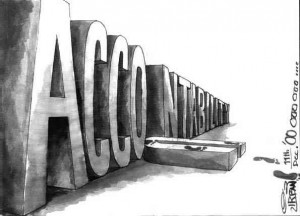Archive for May, 2010
The Improvement Mindset
![]()
![]()
![]()
![]()
 Improvement is good; we all want it. Whether it’s Continuous Improvement (CI), where goodness, however defined, is improved incrementally and continually, or Discontinuous Improvement (DI), where goodness is improved radically and steeply, we want it. But, it’s not enough to want it.
Improvement is good; we all want it. Whether it’s Continuous Improvement (CI), where goodness, however defined, is improved incrementally and continually, or Discontinuous Improvement (DI), where goodness is improved radically and steeply, we want it. But, it’s not enough to want it.
How do we create the Improvement Mindset, where the desire to make things better is a way of life? The traditional non-answer goes something like this: “Well, you know, a lot of diverse factors have to come together in a holistic way to make it happen. It takes everyone pulling in the same direction.” Crap. If I had to pick the secret ingredient that truly makes a difference it’s this:
a
People with the courage to see things as they are.
a
People who can hold up the mirror and see warts as warts and problems as problems – they’re the secret ingredient. No warts, no improvement. No problems, no improvement. And I’m not talking about calling out the benign problems. I’m talking about the deepest, darkest, most fundamental problems, problems some even see as strengths, core competencies, or even as competitive advantage. Problems so fundamental, and so wrong, most don’t see them, or dare see them.
The best-of-the-best can even acknowledge warts they themselves created. Big medicine. It’s easy to see warts or problems in others’ work, but it takes level 5 courage to call out the ugliness you created. Nothing is off limits with these folks, nothing left on the table. Wide open, no-holds-barred, full frontal assault on the biggest, baddest crap your company has to offer. It’s hard to do. Like telling a mother her baby is ugly – it’s one thing to think the baby is ugly, but it’s another thing altogether to open up your mouth and acknowledge it face-to-face, especially if you’re the father. (Disclaimer: To be clear, I do not recommend telling your spouse your new baby is ugly. Needless to say, some things MUST be left unsaid.)
It’s not always easy to be around the courageous souls willing to jeopardize their careers for the sake of improvement. And it takes level 5 courage to manage them. But, if you want your company to contract a terminal case of the Improvement Mindset, it’s a price you must pay.
Click this link for information on Mike’s upcoming workshop on Systematic DFMA Deployment
Imagination’s Obituary
 Anytown, Any Country – Imagination died on Friday, May 14, 2010, following a long and courageous battle with continuous improvement.
Anytown, Any Country – Imagination died on Friday, May 14, 2010, following a long and courageous battle with continuous improvement.
Imagination was born in a time long ago in a place we no longer recognize. Nurtured by her parents Individualism and Free Thinking, Imagination had a wonderful childhood. As a youngster, she was known to make significant contributions to science and technology. Galileo, a long time friend of Imagination, credited her with new thinking about our solar system as well as the invention that made it all happen – the astounding telescope. To the end, Galileo’s support of Imagination never wavered, even after his relationship with her led to the incarceration that shortened his career.
Stories like these are commonplace throughout history. Selflessly, Imagination helped many people throughout her life. She took a behind-the-scenes approach to her work, and never sought credit. She was known to be involved with the most important thinking of our generations including: the Round Earth Theory, the Theory of Relativity, the internal combustion engine, the first lunar landing, and Velcro.
In recent years her health declined as the two new thinking systems, lean and Six Sigma, tricked companies into severely constraining their thinking, and, eventually, there was no longer a place for her. Though she battled valiantly, she finally succumbed to their rhetoric.
In lieu of flowers, memorial donations may be made to The Anti-Lean and Six Sigma Foundation.
Click this link for information on Mike’s upcoming workshop on Systematic DFMA Deployment
Who owns cost?
 I’ve heard product cost is designed in; I’ve heard it happens at the early stages of product development; And, I’ve heard, once designed in, cost is difficult get out. I’m sure you’ve heard this before. Nothing new here. But, is it true? Is cost really designed in? Why do I ask? Because we don’t behave like it’s true. Because was it was true, the Design community would be responsible for product costs. And they’re not.
I’ve heard product cost is designed in; I’ve heard it happens at the early stages of product development; And, I’ve heard, once designed in, cost is difficult get out. I’m sure you’ve heard this before. Nothing new here. But, is it true? Is cost really designed in? Why do I ask? Because we don’t behave like it’s true. Because was it was true, the Design community would be responsible for product costs. And they’re not.
Who gets flogged when the cost of new products are too high? Manufacturing. Who does not? Design. Who gets stuck running cost reduction projects when costs are too high? Manufacturing. Who does not? Design. Who gets the honor of running kaizens when value stream maps don’t have enough value? Manufacturing. Who designs out the value and designs in the cost? Design. (That’s why they’re called Design.) If Design designs it in, why is the cost albatross hung around Manufacturing’s neck?
It sucks to be a manufacturing engineer – all the responsibility to reduce cost without the authority to do it. The manufacturing engineers’ call to arms –
a
Reduce cost, but don’t change anything!
a
Say that out loud. Reduce the cost, but don’t change anything. How stupid is that? We’ll it’s pretty stupid, but it happens every day. And why constrain the manufacturing engineers like that? Because they don’t have the authority to change the product design – only Design can do that. So you’re saying Manufacturing is responsible for product cost, but they cannot change the very thing that creates all the cost? Yes.
What would life be like if we behaved as if Design was responsible for product cost? To start, Design would present product cost data at new product development gate reviews. Design would hang their heads when product costs were higher than the cost target, and they would be held accountable for redesigning the product and meeting the cost target. (They would also be given the tools, time, and training to do the work.)
Going forward, Design would understand the elements of product that create the most cost. And how would they know this? First, they would spend some time on the production floor. (I know this is a little passé, but it still works.) Second, they would do Design for Assembly (DFA) in a hands-on, part-by-part, piece-by-piece way. No kidding, they would handle all the parts themselves, assemble them with production tooling, and score the design with DFA. That’s right, Design would do DFA. The D in DFA does not stand for Advanced Manufacturing, Operations, Supplier Quality, Purchasing, or Industrial Engineering. The D stands for Design.
I know your manufacturing engineers are in favor of rightly burdening Design with responsibility for product cost. But, your Lean Leaders should be the loudest advocates. Imagine if your Design organization designed new products with half the parts and half the material cost, and your Lean Leaders reduced value waste from there. Check that, Lean Leaders should not be the loudest advocates. Your stockholders should be.
Click this link for information on Mike’s upcoming workshop on Systematic DFMA Deployment
If you were a country, what would you do?
 If I was a country I would care about the well-being of my people. I would truly care about the health, education, and happiness of my families. That’s easy to say, but hard to pay for. How would I fund it? I would make stuff, lots of stuff. My rationale – jobs, lots of jobs. I would create a sustainable economy built on the bedrock of manufacturing. I’m not talking about designing things, but actually making them, with real factories, real machines, and real people, because as a country, it’s more important to make things than to design them.
If I was a country I would care about the well-being of my people. I would truly care about the health, education, and happiness of my families. That’s easy to say, but hard to pay for. How would I fund it? I would make stuff, lots of stuff. My rationale – jobs, lots of jobs. I would create a sustainable economy built on the bedrock of manufacturing. I’m not talking about designing things, but actually making them, with real factories, real machines, and real people, because as a country, it’s more important to make things than to design them.
The single most important equation for me as a country is
Price – Cost = Profit.
While companies care most about profit, as a country I care most about cost – manufacturing cost. I want to incur the cost of manufacturing within my borders, and for good reason – that’s where jobs and money are. For a product that sells for $100 with a 20% profit margin, costs ($80) are four times larger than profits ($20). No big deal you say? Pretend you are a country and look at the three components of cost from my perspective – labor, materials, and overhead, and then ask yourself if it’s a big deal.
Labor
My people get paid for their time. (For me, as a country, that’s magic.) They buy food, clothing, and shelter and have a little fun. In turn, they pay me income tax, which I use to educate my children.
Material
My dirt, rocks, and sticks are used in products and my people get paid to dig, move, mix, and cut. (More magic.) And the machines to do it all are made by my people. We then make the same trade as above – they buy food, clothes, shelter, they pay me income taxes, and I use the money to pay for healthcare.
Overhead
My dirt, rocks, and sticks are dug and moved to make electricity. My people get paid, they spend, and I provide services. A good trade for all.
I’m not an economist, and I’m oversimplifying things. And I know there’s more than a hint of nationalism here. But, even still, when I pretend to be a country, all this makes sense to me.
If you were a country, what would you do?
Click this link for information on Mike’s upcoming workshop on Systematic DFMA Deployment
 Mike Shipulski
Mike Shipulski